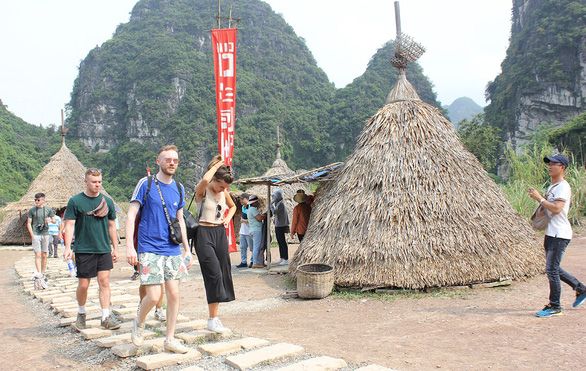A film set arranged for shooting the American monster film Kong: Skull Island within a UNESCO World Heritage Site in northern Vietnam has been dismantled to restore and preserve the natural beauty of the area.
The set, made within the UNESCO-recognized Trang An Scenic Landscape Complex in the northern province of Ninh Binh, was the filming location for a fictional tribal village whose villagers worshipped the mighty monster king Kong in 2016.
As the village played a vital role in the storyline, the film set was reconstructed based on how it appeared in the movie and started to welcome tourists in April 2017.
The imaginary village included 40 tents made of rattan and bamboo, each of which was connected to each other by a small path paved with pieces of stones. ‘Ancient’ objects meant for daily activities of the tribal people were also placed between the tents.
However, authorities in Ninh Binh began breaking down the scenery and its props on Friday, as recommended by the UNESCO.
The UN culture body suggested that the film set could lead to misconception that the imaginary tribal village was native to Trang An, according to Bui Van Manh, deputy director of the provincial tourism department.
A visit to the film set has therefore been removed from the itineraries of some boat tours in Trang An.
Kong: Skull Island, directed by Jordan Vogt-Roberts, is to date the biggest Hollywood movie to have been filmed in Vietnam.
The monster movie, starring Tom Hiddleston, Samuel L. Jackson, John Goodman, and Brie Larson as its main cast, had up to 70 percent of its runtime filmed in the Vietnamese provinces of Quang Binh, Quang Ninh and Ninh Binh.
The film racked up US$538.4 million in theaters merely a month after its premiere in March 2017, against a budget of $185 million, according to box office tracking site Box Office Mojo.
In the future, Ninh Binh has plans to set up an ancient Vietnamese village that will serve as an outdoor museum in lieu of the fictional tribal village, according to an official at the UNESCO office in Hanoi.
The museum is expected to help visitors have a better understanding of the evolution and adaptation of prehistoric humans in the Trang An scenic complex in particular and in Southeast Asia in general.
Such a venue matches the mixed cultural and natural values that Trang An is recognized for.
Evidence of ancient human activity dating back to 30,000 years ago was uncovered within the cultural landscape after 14 archeological researches and explorations here, according to a report by the municipal tourism department.
Like us on Facebook or follow us on Twitter to get the latest news about Vietnam!


















































